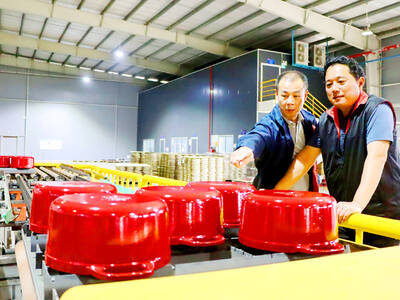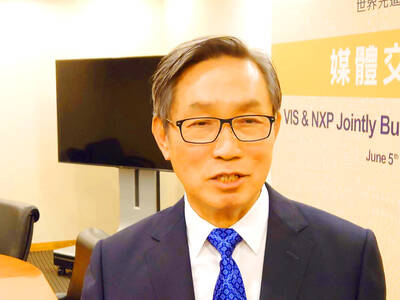TAIEX stages rebound
The TAIEX staged a technical rebound yesterday following sell-offs in the previous session, with buying focusing on bellwether tech stocks, dealers said.
However, turnover shrank as many investors stayed on the sidelines amid lingering concerns over the weakening US economy and the debt crisis in the eurozone, they said.
The index closed up 161.82 points, or 2.2 percent, at the day’s high of 7,529.01, off an early low of 7,428.70, on turnover of NT$91.49 billion (US$3.14 billion).
Chunghwa Picture’s sales up
Panel maker Chunghwa Picture Tubes Ltd (華映) yesterday reported net sales of NT$5.17 billion last month, up 10 percent month-on-month, but down 22.2 percent year-on-year.
Net sales from its panel business units hit NT$4.88 billion last month, up 12 percent from July, but down 18.6 percent from the same month last year, according to a statement.
Of that, shipments of large-sized panels were up 9.7 percent month-on-month, but down 42.2 percent from last year.
Shipments of small and medium-sized panels climbed 22 percent from a month earlier and 26.9 percent from last year, the company said.
Chinatrust, Mega profits slide
Chinatrust Financial Holding Co (中信金控), the nation’s third-largest financial service provider, yesterday posted a net profit of NT$1.21 billion last month, down 23.66 percent from one month earlier and 9.7 percent from a year ago, as the company set aside more loan loss reserves linked to loss-making ProMOS Technologies Inc (茂德科技), the company said in a statement.
For the first eight months of the year, Chinatrust’s net earnings totaled NT$13.94 billion, or earnings of NT$1.33 per share, the statement said.
The firm said net income would have outpaced July’s figures without the NT$1.03 billion in bad loan provision.
Meanwhile, Mega Financial Holding Co (兆豐金控) posted a net profit of NT$1.34 billion last month, down 37.2 percent from one month earlier, but up 5.5 percent from a year ago, according to its stock exchange filing.
Cumulative net income for the first eight months of the year reached NT$12.92 billion, or NT$1.15 per share.
Taiwan at green tech show
Taiwan has doubled its presence at this year’s International Greentech & Eco Products Exhibition and Conference in Malaysia, a four-day event that opened yesterday at the Kuala Lumpur Convention Center.
The nation is being represented this year by 33 exhibitors at 35 booths, compared with only 14 companies and booths last year, Deputy Representative to Malaysia Lin Ming-li (林明禮) said.
Trade delegation on tour
A Taiwanese delegation has concluded a trade promotion visit to Mexico and left for Nicaragua on Sunday to continue its 13-day Central America tour with the goal of finding new markets for Taiwan’s technology products.
Wang Chung-yu (王鍾渝), chairman of the Taipei-based Chinese International Economic Cooperation Association (CIECA), and Arturo Mendicuti, chairman of Mexico City’s economic federation, presided over an investment conference on Sept. 1 where the two sides exchanged views.
After spending three days in Nicaragua, the delegation will head to Peru for a four-day visit.
NT dollar loses ground
The New Taiwan dollar fell against the US dollar yesterday, closing down NT$0.003 at NT$29.115 on turnover of US$771 million.

TAKING STOCK: A Taiwanese cookware firm in Vietnam urged customers to assess inventory or place orders early so shipments can reach the US while tariffs are paused Taiwanese businesses in Vietnam are exploring alternatives after the White House imposed a 46 percent import duty on Vietnamese goods, following US President Donald Trump’s announcement of “reciprocal” tariffs on the US’ trading partners. Lo Shih-liang (羅世良), chairman of Brico Industry Co (裕茂工業), a Taiwanese company that manufactures cast iron cookware and stove components in Vietnam, said that more than 40 percent of his business was tied to the US market, describing the constant US policy shifts as an emotional roller coaster. “I work during the day and stay up all night watching the news. I’ve been following US news until 3am

Six years ago, LVMH’s billionaire CEO Bernard Arnault and US President Donald Trump cut the blue ribbon on a factory in rural Texas that would make designer handbags for Louis Vuitton, one of the world’s best-known luxury brands. However, since the high-profile opening, the factory has faced a host of problems limiting production, 11 former Louis Vuitton employees said. The site has consistently ranked among the worst-performing for Louis Vuitton globally, “significantly” underperforming other facilities, said three former Louis Vuitton workers and a senior industry source, who cited internal rankings shared with staff. The plant’s problems — which have not

TARIFF CONCERNS: The chipmaker cited global uncertainty from US tariffs and a weakening economic outlook, but said its Singapore expansion remains on track Vanguard International Semiconductor Corp (世界先進), a foundry service provider specializing in producing power management and display driver chips, yesterday withdrew its full-year revenue projection of moderate growth for this year, as escalating US tariff tensions raised uncertainty and concern about a potential economic recession. The Hsinchu-based chipmaker in February said revenues this year would grow mildly from last year based on improving supply chain inventory levels and market demand. At the time, it also anticipated gradual quarter revenue growth. However, the US’ sweeping tariff policy has upended the industry’s supply chains and weakened economic prospects for the world economy, it said. “Now

COLLABORATION: Given Taiwan’s key position in global supply chains, the US firm is discussing strategies with local partners and clients to deal with global uncertainties Advanced Micro Devices Inc (AMD) yesterday said it is meeting with local ecosystem partners, including Taiwan Semiconductor Manufacturing Co (TSMC, 台積電), to discuss strategies, including long-term manufacturing, to navigate uncertainties such as US tariffs, as Taiwan occupies an important position in global supply chains. AMD chief executive officer Lisa Su (蘇姿丰) told reporters that Taiwan is an important part of the chip designer’s ecosystem and she is discussing with partners and customers in Taiwan to forge strong collaborations on different areas during this critical period. AMD has just become the first artificial-intelligence (AI) server chip customer of TSMC to utilize its advanced